Understanding the content in census record
- Household returns 1921 Census
- Description of enumeration district
Official copies of census records
Background
The census provides a snapshot of the people at a particular address on a given night. This information can be used to further your search for direct ancestors, to broaden your knowledge of the local community and to act as a bridge between the statutory registers and parish records.
An official census of population has been taken every ten years since 1801 (with the exception of the wartime year of 1941 when no census was taken) and of the sample census of 1966. Additionally, the census originally planned for 2021 was moved to 2022 due to the impact of the COVID-19 pandemic.
Little information about individuals survives for 1801 to 1831. From 1841 to 1921 enumerators copied information from schedules completed by heads of households and of smaller institutions into enumeration books for each district. Larger institutions were districts in their own right and had separate books. The original schedules have been destroyed but the enumeration books are held in the custody of the Registrar General for Scotland in Edinburgh. The records are indexed by personal name and are available as digital images.
Please note that some original 1841 census enumeration books have not survived - details are given at 1841 Census missing records below.
The censuses were taken at midnight on:
- 6 June 1841
- 30 March 1851
- 7 April 1861
- 2 April 1871
- 3 April 1881
- 5 April 1891
- 31 March 1901
- 2 April 1911
- 19 June 1921
Census records are closed for 100 years under the Freedom of Information (Scotland) Act 2002.
How to search census records
Census returns is a record category in advanced search and covers the 1841 to 1921 Scottish censuses. Go to search the records - Census returns, select a census year and search on some or all of the following:
- Surname - spellings can vary but there are several search options available as explained in the surnames guide
- Forename - you may find variations in names, for example, Margaret may be enumerated as Maggie
- Second person forename - add the name of another person you would expect to find in the household to narrow your search. Please note that this search looks for names on the same census page. As a result, it does sometimes find name matches for people who are not in the same household. It won’t find a match if the household is over two pages, and the names are on separate pages.
- Gender
- Age range - in 1841 the ages of people over 15 years were rounded down to the nearest five, for example 29 was recorded as 25, although you will still find some exact ages; from 1851 exact age is recorded
- County - includes shipping (from 1851)
- District - please note that not all districts are valid for all years. If a search returns no results for a specific district, try widening the search to 'All Districts' for the county. Find out more in our guide to parishes and districts.
There is one search form with tips for each field and links to more detailed research guides where appropriate. You can sort search results by any field.
If you cannot find a family in the census records, try the valuation rolls where you can search by address. Find out about these records in the valuation rolls guide.
If you do search people records on the home page of Scotland's People with years in the range 1841 to 1921 your results will almost certainly include census records.
1881 (LDS index)
This is an additional index for the 1881 Census which links to a transcription rather than a digital image of the record. The indexing was coordinated by the Church of Jesus Christ of Latter-Day Saints (LDS). The search form includes address, census place and birth place rather than county and district. The transcriptions are free to view.
Census street indexes
These indexes provide parish or registration district and enumeration book references for each road or street in urban areas. They also cover institutions, hotels, police stations and so on. They are published in portable document format (pdf) on the census records pages of the National Records of Scotland website.
- 1841 Census street indexes
(Edinburgh and Glasgow)
- 1851 Census street indexes
(Aberdeen, Dundee, Edinburgh and Leith, Glasgow, Greenock, Inveresk, New Monkland, Old Aberdeen, Old Monkland, and Paisley)
- 1861 Census street indexes
(Aberdeen; Airdrie; Arbroath; Ayr, St Quivox and Newton-on-Ayr; Brechin; Dumfries; Dundee; Edinburgh; Glasgow; Greenock; Kilmarnock; Kirkcaldy, Abbotshall and Dysart; Lanark; Old Monkland; Paisley and Abbey; and Perth)
- 1871 Census street indexes
(Aberdeen; Arbroath; Ayr; Bothwell and Holytown; Brechin; Cadder (Western District) and Cadder (Eastern District); Calderhead; Cambusnethan; Campbeltown; Dalry; Dumfries; Dundee; Dunfermline; Edinburgh and Leith; Falkirk; Forfar; Glasgow; Greenock; Hamilton; Hawick; Inverness; Kilmarnock; Kirkcaldy; Lesmahagow; Montrose; New Monkland; Old Monkland; Paisley; Perth; Peterhead; Rothesay; Rutherglen; Shotts; Stirling; and Stornoway)
- 1881 Census street indexes
(Aberdeen; Arbroath; Ardnamurchan; Ayr; Bothwell; Cadder; Calderhead; Cambusnethan; Dalziel; Dundee; Dunfermline; Edinburgh; Glasgow; Greenock; Hamilton; Hawick; Holytown; Inverness; Kilmarnock; Kirkcaldy; Montrose; New Monkland; Old Monkland; Paisley; Perth; Peterhead; Rutherglen; Shotts; Stornoway)
- 1891 Census street indexes
(Aberdeen; Ayr; Barvas, Carloway, Lochs, Stornoway and Uig; Bothwell and Holytown; Cambusnethan; Dalziel; Dundee; Dunfermline; Edinburgh; Glasgow; Greenock; Hamilton; Hawick and Wilton; Inverness; Kilmarnock; Kirkcaldy and Dysart; Montrose; New Monkland; Old Monkland; Paisley; Perth, Kinnoull and Scone; and Shotts, Calderhead and Cadder)
- 1901 Census street indexes
(Aberdeen and Nigg; Ayr; Bonhill and Renton; Bothkennar, Grangemouth and Polmont; Bothwell, Holytown and Bellshill; Cadder East and West Districts; Calderhead; Cambuslang; Cambusnethan; Dalziel; Dumbarton ; Dumfries; Dundee; Dunfermline; Edinburgh; Falkirk ; Glasgow; Greenock, Gourock and Port Glasgow area; Hamilton; Hawick; Hebrides; Inverness; Inverness Insular; Kilmarnock; Kirkcaldy; Montrose; New Kilpatrick (or East Kilpatrick); New Monkland; Old Kilpatrick; Old Monkland; Paisley, Johnstone, etc; Perth (with Scone, etc); Shotts; St Ninians and Cambusnethan; Stirling; Stornoway)
- 1911 Census street indexes
(Aberdeen; Ayr; Bonhill; Bothkennar, Grangemouth and Polmont; Bothwell, Holytown and Bellshill; Cambusnethan; Dalziel; Dumfries; Dunbarton; Dundee; Dunfermline; East and West Calder; Edinburgh; Falkirk; Glasgow; Greenock, Gourock and Port Glasgow; Hamilton; Hawick; Inverness; Kilmarnock; Kirkcaldy and Dysart; Lewis and Harris; Montrose; New Kilpatrick; New Monkland; Old Kilpatrick; Old Monkland - Western District, Coatbridge and Old Monkland - Eastern District; Paisley, Johnstone and Elderslie; Perth; Skye; St Ninians; and Stirling)
- 1921 Census street indexes
(Aberdeen; Dundee; Dunfermline; Edinburgh; Glasgow; Hebrides; Inverness; Kirkcaldy; Montrose; and Perth)
Understanding the content in census records
Each search result includes a view image link. This opens a digital image of the relevant page in the enumeration book. You have options to 'browse forwards', 'browse backwards' and 'view header (free)'. The header contains digital images of the preliminary section of the enumeration book including the title page, description of the enumeration district and summary statistics compiled by the enumerator. They are free to view.
Household returns
Most records include the following information:
- Address of the house or institution
- Surname and forename of each person
- Relationship to head of household (except 1841) of family members, visitors, lodgers and servants
- Whether single, married or widowed
- Age - in 1841 this was rounded down for persons over 15 years although you will still find some exact ages given
- Occupation - if you find an abbreviation or unknown term check the glossary or the index to occupations (1911 Census report, volume II, pages 437-445) which is published on the Online Historical Population Reports (Histpop) website
- Birthplace – for 1841 this shows whether the person was born in the county (yes or no), in England, Ireland or elsewhere (foreign) but from 1851 gives the county and parish or country of birth
- Gaelic (from 1891) shows whether the person spoke G (Gaelic) or G and E (Gaelic and English)
- Rooms with one or more windows (from 1861) – this information was used to assess housing conditions.
- Disability - whether blind, deaf, dumb and so on.
- Fertility of marriage (1911)
- Orphans living in the household (1921)
- Marriage - whether a marriage had been ‘dissolved by Divorce’ (1921)
This example from the 1901 Census is for the household of Charles Rennie MacKintosh, architect and Margaret MacDonald MacKintosh, artist. Click on the image to see the schedule (124) and census page (28) in full. They lived at 120 Main Street in Glasgow where Margaret was working on her own account. Their servant, Maggie Macdonald, was from the Highlands and spoke both Gaelic and English. On census night they also had a visitor whose birthplace is given as Cape of Good Hope. The home had seven rooms with one or more windows which would indicate good housing and sanitary conditions.

Detail of 1901 Census record (National Records of Scotland, 1901/644-7/23, schedule 124)
The colour image at the top of this page is an extract from the 1901 Census for Leith (National Records of Scotland, 1901/692-2/10B, page 10)
Household returns 1921 Census
The Census Branch files of the General Register Office for Scotland (Registrar General) include specimen schedules from the 1921 Census. Instructions and examples are given on the obverse of the form and the questions on the reverse.
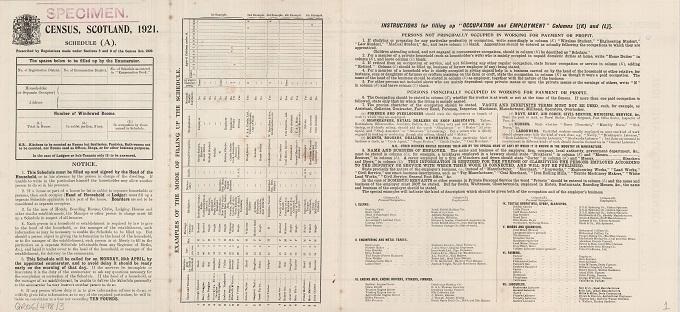
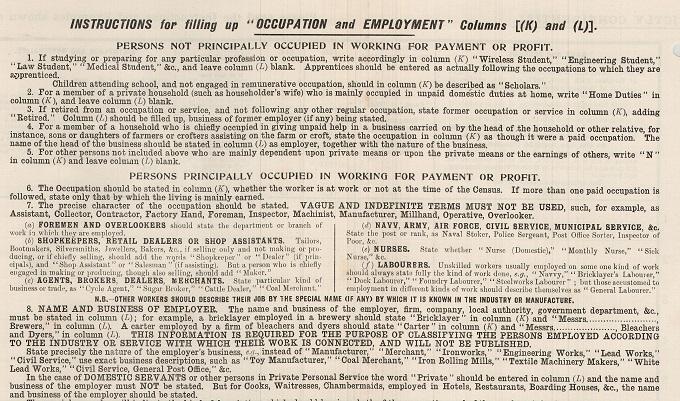
Details of instructions contained in Schedule A, 1921 census, Scotland.
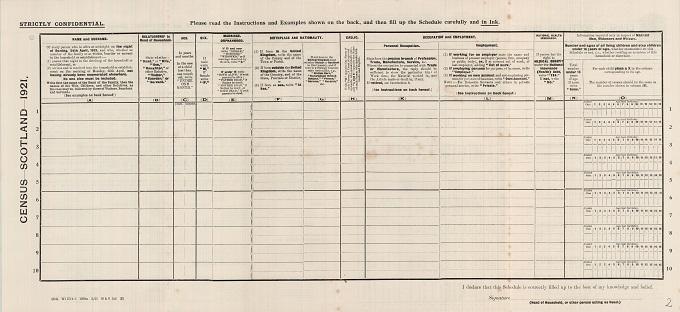
Reverse side of specimen sample of Schedule A, 1921 census, Scotland.
Crown copyright, National Records of Scotland, GRO6/478/3, page 2

Reverse side of specimen sample of Schedule A, 1921 census (detail, columns 'a' to 'h').

Reverse side of specimen sample of Schedule A, 1921 census (detail, columns 'k' to 'o').
Please note, there are no columns for 'i', 'j', 'p-z' on the schedule.
The guide, 'Instructions to Registrars and Enumerators', (pages 28-30), emphasised the 'special attention' enumerators should pay to checking that each column in the schedule had been completed correctly by the head of the household. When the enumerators copied this information into the transcript books, they used abbreviations. For example:
Marriage/Orphanhood
- BA - Both parents alive
- FD - Father dead
- MD - Mother dead
- BD - Both parents dead
Occupation and Employment
- HD - Home/Household duties
- E - Employer
- W - Worker (employee)
- OA - Own account (i.e. self-employed)
- Ret - Retired
- OW - Out of work
Institutions
Enumeration books for larger institutions or establishments such as barracks, hospitals, prisons and schools are in a different format. Here's an example from the 1861 Census for the Boys' and Girls' Schools of Industry in King James the Sixth's Hospital in Perth. Click on the image to view the full census page.

Detail from 1861 Census page for an institution in Perth (National Records of Scotland, 1861/387-1/46, page 4)
To find out the name of the institution select the 'view header (free)' button above the census image. The title page will be displayed. Here's a detail from the title page of the institution in the example above. Click on the image to view the full page.
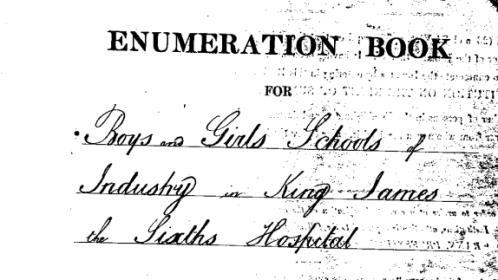
Detail from 1861 Census title page for an institution in Perth (National Records of Scotland, 1861/387-1/46)
Description of enumeration district
Standard enumeration books include a description of the area covered. You can view these preliminary or introductory pages as digital images by selecting the 'view header (free)' button above the census image. The title page is displayed with the option to browse the following pages for free. This example is from the 1881 Census for Kirkcudbright (National Records of Scotland, 1881/871/2). It describes enumeration district two as:
'Parish of Kirkcudbright
Second District
So much of the Burgh of Kirkcudbright as lies on the West Side of the High Street leading from the Market Cross to the Harbour namely from St Marys Wynd to the House of Thomas Beatie, Fisherman and including the House at Castle Dykes and Bells Barn and also including the Part of East Side of High St from the Castle to Union Street. Number of separate familys 103.'
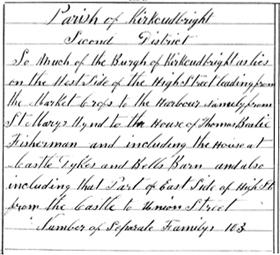
Find out more about enumeration districts for parishes and institutions in the topic guide parishes and districts.
Shipping returns
People on board boats and barges on inland waterways were enumerated in the district where they were based on census night. Crews on board ships at sea or in Irish or English ports were enumerated separately. This example for the 'Almora' of Glasgow is from an 1881 Census return of Scottish shipping in English ports. It provides information about members of her crew who were born in India.
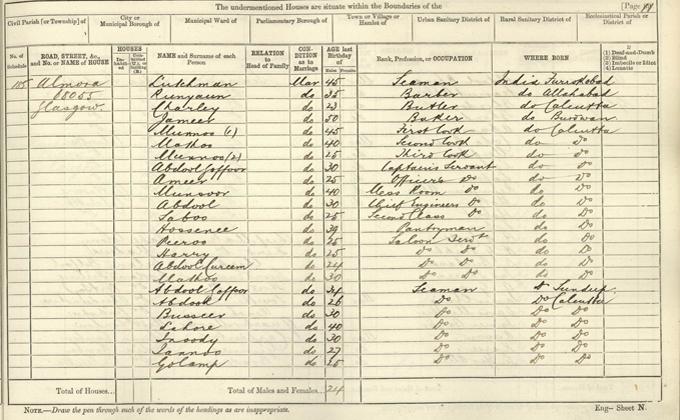
1881 Census return for the 'Almora' (National Records of Scotland, 1881/903S/999-1, page 11)
Official copies of census records
Please note that if you require an official copy of an 1841 to 1921 Census record for legal purposes please get in touch using the following link: Contact | Scotland's People
1841 Census missing records
The list below is arranged by parish reference number. Some original 1841 Census records have not survived - mostly for parishes in Fife.
- 93 - Cromdale, Moray - entries can be found under Inverallan
- 167 - Seafield, Banffshire - book has no entries
- 324 - Aberfeldy, Perthshire - book has no entries
- 326 - Abernethy - enumeration book for people living in Fife missing
- 367 - Kinloch Rannoch, Perthshire - book has no entries
- 400 - Abdie, Fife - book has no entries
- 404 - Arngask - enumeration book for people living in Fife missing
- 406 - Auchtermuchty, Fife - book has no entries
- 409 - Balmerino, Fife - book has no entries
- 415 - Ceres, Fife
- 416 - Collesie, Fife
- 418 - Creich, Fife
- 419 - Cults, Fife
- 420 - Cupar, Fife
- 421 - Dairsie, Fife
- 423 - Dunbog, Fife
- 434 - Kennoway - only the enumeration book for Markinch has survived
- 439 - Kinghorn, Fife - book has no entries
- 440 - Kinglasie, Fife - book has no entries
- 442 - Kirkcaldy, Fife - book has no entries
- 444 - Leslie, Fife - book has no entries
- 509 - Cumlodden, Argyll - book has no entries
- 535 - Tarbert, Argyll - book has no entries
- 556 - Lochranza, Bute - book has no entries
- 557 - North Bute, Bute - book has no entries
- 577 - Auchinleck, Ayrshire - book has no entries
- 776 - Kirkhope, Selkirkshire - book has no entries
- 809 - Teviothead, Roxburghshire - book has no entries
- 862 - Corsock Bridge, Kirkcudbrightshire - book has no entries
- 864 - Dalbeattie, Kirkcudbrightshire - book has no entries
Pre-1841 census records
Few pre-1841 census records about individuals survive. An overview is provided in the guide pre-1841 census records on the National Records of Scotland website.